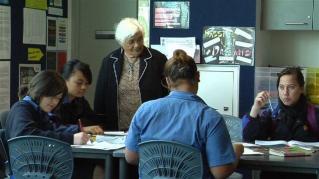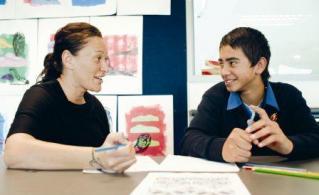Section navigation
20/03/2012
2012 Te Kotahitanga report: Maintaining, replicating and sustaining change.
Te Kotahitanga is a research-based professional development programme to raise Maori educational achievement by supporting teachers and school leaders to become more culturally responsive. The Te Kotahitanga effective teaching profile consists of two ‘essential understandings’ which effective teachers of Māori students have, and six dimensions (relationships) of teaching that effective teachers of Māori students demonstrate in their classrooms on a daily basis. These are underpinned by the integral concepts that form the basis of the Te Kotahitanga professional development model.
Essential understandings
The two essential understandings are that, to be effective teachers of Māori students, teachers must understand the need to:
- reject deficit theorising as a way of explaining Māori students’ educational achievement levels
- take an agentic position [1] in their theorising about their practice, and accept professional responsibility for the learning of all students, including Māori students.
Relationships (dimensions) of teaching
The two essential understandings are demonstrated through six main dimensions (relationships) of teaching and learning:
- manaakitanga: caring for students as culturally located individuals
- mana motuhake: having high expectations for students’ learning
- whakapiringatanga: managing classrooms so as to promote learning
- wānanga: engaging in effective teaching interactions with Māori students as Māori
- ako: using a range of strategies that support learning and teaching
- kotahitanga: monitoring student achievement data and using the information to modify teaching practice in ways that lead to improvements in Māori student achievement, and sharing this information with students.
Culturally responsive pedagogy of relations
Implementation of the effective teaching profile promotes contexts for learning where:
- power is shared
- ‘culture counts’, and learners cultural knowledge is valued
- learning is interactive and dialogic [2]
- there is ‘connectedness’ of teachers with learners, demonstrated by teachers’ commitment to their students and the students’ communities
- there is a common vision and agenda for excellence for Māori in education
The purpose of this report is to document the outcomes of the implementation of Te Kotahitanga in Phase 3 and 4 secondary schools from 2007 to 2010. During these four years, the Phase 3 schools were in their fourth to seventh year of implementing the project in their schools. Phase 4 schools were in their first to fourth years of the programme.
The report examines:
- whether the Phase 3 schools were able to maintain the gains they had made in teacher practices and student achievement during the first three years of the project
- if the Phase 4 schools are following a similar pathway to the earlier group of schools (Phase 3) in their implementation of the project.
The research project sought to identify the conditions necessary for the schools to sustain and embed the practices and learning from Te Kotahitanga.
The full report is accompanied by a summary report. For the fully documented findings, refer to the full report, available on the Education Counts website or download the summary report below.
[1] In the context of teaching, taking an agentic position refers to accepting that one can ‘make a difference’ to student learning and achievement, that one has a professional responsibility to do so, and then acting on that responsibility.
[2] ‘Dialogic’ is the term used to describe a relationship that involves dialogue—that is, opportunities are made to learn through conversations between the learner and teacher.
Te-Kotahitanga-Summary (4 MB)
Filed under: Research & evaluation | Effective leaders | Effective teachers | Te Kotahitanga





